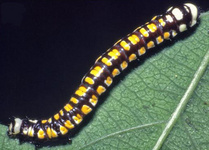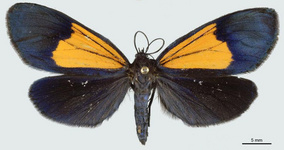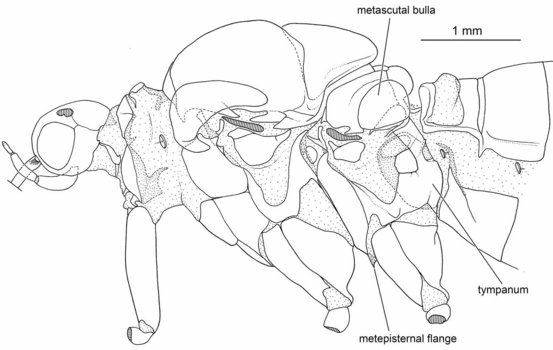Josiini
James S. Miller and Andrew V. Z. Brower


This tree diagram shows the relationships between several groups of organisms.
The root of the current tree connects the organisms featured in this tree to their containing group and the rest of the Tree of Life. The basal branching point in the tree represents the ancestor of the other groups in the tree. This ancestor diversified over time into several descendent subgroups, which are represented as internal nodes and terminal taxa to the right.

You can click on the root to travel down the Tree of Life all the way to the root of all Life, and you can click on the names of descendent subgroups to travel up the Tree of Life all the way to individual species.
For more information on ToL tree formatting, please see Interpreting the Tree or Classification. To learn more about phylogenetic trees, please visit our Phylogenetic Biology pages.
close boxIntroduction
A group of neotropical day-flying moths with black and yellow aposematic color patterns.Characteristics
Josiini possess a unique metathoracic tympanal organ that separates them from other moths. In addition, rami of the antennae are joined to the antennal shaft with hingelike joints, fore- and hindwing veins M3 and CuA1 are stalked, and forewings lack stridulatory organs (Miller 2009).
Larvae have a glassy surface to the head capsule and go through four instars. Pupae on the inderside of leaves are surrounded by a loose net of silk.
A diagram of josiine thoracic structures. Note the kettle drum-shaped metathoracic tympanum.Discussion of Phylogenetic Relationships
The hypothesis of relationships among josiine genera is based on a cladistic analysis of larval and adult morphological characters (Miller 2009).References
Miller JS. 1996. Phylogeny of the Neotropical moth tribe Josiini (Notodontidae: Dioptinae): a hidden case of Müllerian mimicry. Zool. J. Linn. Soc. 118, 1-45.
Miller, JS. 2009. Generic revision of the Dioptinae (Lepidoptera: Noctuoidea: Notodontidae). Bulletin of the American Museum of Natural History 321, 1-971 + 48 plates.
Miller JS, Brower AVZ. & Desalle R. 1997. Phylogeny of the neotropical moth tribe Josiini (Notodontidae: Dioptinae): comparing and combining evidence from DNA sequences and morphology. Biol. J. Linn. Soc. 60, 297-316.
Title Illustrations

| Scientific Name | Lyces flavissima |
|---|---|
| Location | Venezuela |
| Reference | Miller JS. 2009. Generic revision of the Dioptinae (Lepidoptera: Noctuoidea: Notodontidae). Bulletin of the American Museum of Natural History 321, 1-971 + 48 plates. (Plate 39) |
| Creator | L. D. Otero |
| Specimen Condition | Live Specimen |
| Identified By | James S. Miller |
| Life Cycle Stage | larva |
| View | dorsal-lateral |
| Image Use |
 This media file is licensed under the Creative Commons Attribution License - Version 3.0. This media file is licensed under the Creative Commons Attribution License - Version 3.0.
|
| Copyright |
© 2009
James S. Miller

|
| Scientific Name | Josia sp. |
|---|---|
| Location | Ecuador |
| Comments | Note the net of silk strands surrounding the pupa. |
| Reference | Miller JS. 2009. Generic revision of the Dioptinae (Lepidoptera: Noctuoidea: Notodontidae). Bulletin of the American Museum of Natural History 321, 1-971 + 48 plates. (Plate 39) |
| Creator | J. E. Rawlins |
| Specimen Condition | Live Specimen |
| Identified By | James S. Miller |
| Life Cycle Stage | pupa |
| View | lateral |
| Image Use |
 This media file is licensed under the Creative Commons Attribution License - Version 3.0. This media file is licensed under the Creative Commons Attribution License - Version 3.0.
|
| Copyright |
© 2009
James S. Miller

|
| Scientific Name | Scea superba |
|---|---|
| Location | Ecuador: Napo, Yanayacu Biological Station, 5 km w Cosanga 00°35.9'S, 77°53.4' W 2163 m. |
| Reference | Miller JS. 2009. Generic revision of the Dioptinae (Lepidoptera: Noctuoidea: Notodontidae). Bulletin of the American Museum of Natural History 321, 1-971 + 48 plates. (Plate 34) |
| Specimen Condition | Live Specimen |
| Identified By | James S. Miller |
| Sex | Male |
| Life Cycle Stage | adult |
| View | dorsal |
| Collection | AMNH |
| Collector | Harold Greeney et al. |
| Image Use |
 This media file is licensed under the Creative Commons Attribution License - Version 3.0. This media file is licensed under the Creative Commons Attribution License - Version 3.0.
|
| Copyright |
© 2009
James S. Miller

|
About This Page
Andrew V. Z. Brower

Middle Tennessee State University, Murfreesboro, Tennessee, USA
Correspondence regarding this page should be directed to James S. Miller at
jmiller@amnh.org
and Andrew V. Z. Brower at
abrower@mtsu.edu
Page copyright © 2010 James S. Miller and Andrew V. Z. Brower
 Page: Tree of Life
Josiini .
Authored by
James S. Miller and Andrew V. Z. Brower.
The TEXT of this page is licensed under the
Creative Commons Attribution-NonCommercial License - Version 3.0. Note that images and other media
featured on this page are each governed by their own license, and they may or may not be available
for reuse. Click on an image or a media link to access the media data window, which provides the
relevant licensing information. For the general terms and conditions of ToL material reuse and
redistribution, please see the Tree of Life Copyright
Policies.
Page: Tree of Life
Josiini .
Authored by
James S. Miller and Andrew V. Z. Brower.
The TEXT of this page is licensed under the
Creative Commons Attribution-NonCommercial License - Version 3.0. Note that images and other media
featured on this page are each governed by their own license, and they may or may not be available
for reuse. Click on an image or a media link to access the media data window, which provides the
relevant licensing information. For the general terms and conditions of ToL material reuse and
redistribution, please see the Tree of Life Copyright
Policies.
- First online 12 August 2009
- Content changed 10 January 2010
Citing this page:
Miller, James S. and Andrew V. Z. Brower. 2010. Josiini . Version 10 January 2010 (under construction). http://tolweb.org/Josiini/138572/2010.01.10 in The Tree of Life Web Project, http://tolweb.org/










 Go to quick links
Go to quick search
Go to navigation for this section of the ToL site
Go to detailed links for the ToL site
Go to quick links
Go to quick search
Go to navigation for this section of the ToL site
Go to detailed links for the ToL site